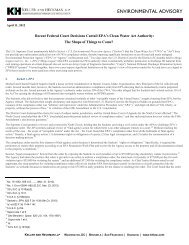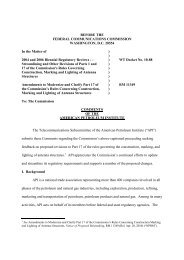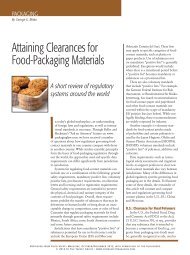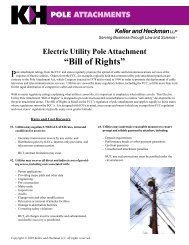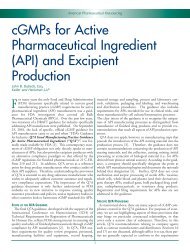A Practical Understanding of the Polymer ... - Keller Heckman
A Practical Understanding of the Polymer ... - Keller Heckman
A Practical Understanding of the Polymer ... - Keller Heckman
You also want an ePaper? Increase the reach of your titles
YUMPU automatically turns print PDFs into web optimized ePapers that Google loves.
<strong>Polymer</strong> Exemption Requirements<br />
Alternatively, an importer could file a PMN for <strong>the</strong> polymer without qualifying <strong>the</strong><br />
reactant. Ei<strong>the</strong>r remedy involves additional time and money.<br />
2. (d)(1); Positively Charged <strong>Polymer</strong>s<br />
The exclusion under paragraph (d)(1) eliminates a cationic or potentially<br />
cationic polymer from <strong>the</strong> exemption unless its charge density is sufficiently low or<br />
it is a non-dispersible, non-soluble solid. Cationic polymers are those that include<br />
molecules that contain a positive charge. <strong>Polymer</strong>s that are associated with nonpolymeric,<br />
positive counterions are not cationic polymers. <strong>Polymer</strong>s are potentially<br />
cationic if <strong>the</strong>y are reasonably anticipated to become cationic in a natural aquatic<br />
environment (e.g., polymers that bear one or more amino groups or isocyanate<br />
groups 4/ that can hydrolyze to amino groups). A polymer is ineligible for <strong>the</strong><br />
exemption if <strong>the</strong> equivalent weight <strong>of</strong> all cationic groups is less than 5000 5/ —<br />
unless <strong>the</strong> polymer is a solid that is nei<strong>the</strong>r soluble nor dispersible in water and will<br />
only be used as a solid. 6/ A threshold <strong>of</strong> 5000 equivalent weight means that <strong>the</strong><br />
mass <strong>of</strong> <strong>the</strong> substance that constitutes one molar unit <strong>of</strong> positive charge is 5000<br />
grams or greater. The (d)(1) exclusion applies solely to cationic groups; <strong>the</strong>refore,<br />
while <strong>the</strong> presence <strong>of</strong> potentially cationic groups might trigger this exclusion, such<br />
polymers could still be eligible for <strong>the</strong> polymer exemption if <strong>the</strong> actual charge in<br />
<strong>the</strong> natural aquatic environment is below <strong>the</strong> threshold concentration. 7/ Please note<br />
that simultaneous incorporation <strong>of</strong> negative charge does not cancel positive charge<br />
for <strong>the</strong> purpose <strong>of</strong> this exclusion.<br />
In addition, please note that equivalent weight is not necessarily related to molecular<br />
weight. The molecular weight may be high or low for <strong>the</strong> same equivalent weight<br />
and vice versa. The equivalent weight <strong>of</strong> a substructure is only related to molecular<br />
weight when <strong>the</strong> mean number <strong>of</strong> substructures per molecule is accurately known.<br />
3. (d)(2); Atomic Element Limitations<br />
The second exclusion limits <strong>the</strong> identities <strong>of</strong> <strong>the</strong> atomic elements that constitute<br />
an eligible polymer. All eligible polymers must contain as an integral part <strong>of</strong><br />
<strong>the</strong>ir composition two or more <strong>of</strong> <strong>the</strong> atomic elements, carbon, hydrogen, nitrogen,<br />
oxygen, silicon, and sulfur. In <strong>the</strong> original polymer exemption this kind <strong>of</strong> requirement<br />
was accompanied by a requirement for a minimum level <strong>of</strong> carbon. Therefore<br />
in <strong>the</strong> original polymer exemption, one <strong>of</strong> <strong>the</strong> two elements had to be carbon and<br />
essentially <strong>the</strong> balance <strong>of</strong> <strong>the</strong> mass had to consist <strong>of</strong> hydrogen, nitrogen, oxygen,<br />
silicon, or sulfur atoms or any combination <strong>of</strong> one or more <strong>of</strong> <strong>the</strong>se atoms.<br />
Additionally, <strong>the</strong> specific monatomic counter ions, Na + , Mg +2 , Al +3 , K + , and<br />
Ca +2 are permitted. Also, chlorine, bromine, and iodine are permitted whe<strong>the</strong>r <strong>the</strong>y<br />
are covalently bound to carbon or as <strong>the</strong> specific monatomic counter ions, Cl - , Br - ,<br />
and I - . Fluorine is permitted, but only if it is covalently bound to carbon; fluorine<br />
is never permitted as any ion. Ei<strong>the</strong>r alone or in any combination, <strong>the</strong> atomic elements,<br />
lithium, boron, phosphorus, titanium, manganese, iron, nickel, copper, zinc,<br />
tin, or zirconium are permitted at less than 0.20 weight percent total.<br />
6




